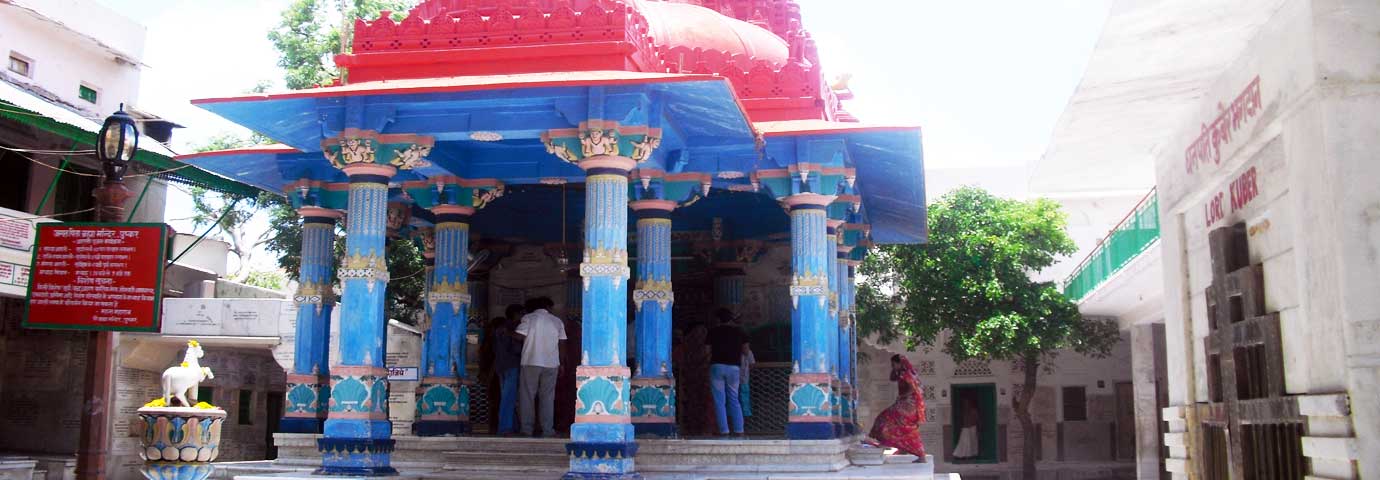Brahma temple in Pushkar is a rare religious site that is dedicated to the lord of creation, Lord Brahma. The reason behind it being rare is that the temple is amongst the very few existing temples of Lord Brahma in India. Known as the Jagatpita Brahma Mandir, this Hindu temple has its address in the Pushkar town of Rajasthan.
Days of construction of this temple dates back to the 14th century. However, Indian Mythology believes the origin of this temple took place 2000 years back in the history. Located close to the sacred Pushkar Lake, the temple is a highly prominent tourist attraction; with large flock of tourists visiting it especially on the auspicious occasion of Kartik Poornima.
History
As per the sacred scripture of Hindu religion; Padma Purana, Lord Brahma once came across a demon named Vajranabha, killing and torturing people. Seeing such atrocity, the Lord slayed the demon with lotus flower (his special weapon). While doing so, some petals from the lotus flower fell at three places on the ground. This resulted into the creation of three sacred lakes, which in today’s times are known as the Jyestha Pushkar, the Madhya Pushkar and Kanishta Pushkar.
Later on, when the lord made his visit to earth, he started with the preparations of a yajna (fire sacrifice) at the Jyestha Pushkar Lake. In order to perform the yajna undisturbed by the demons, Lord Brahma created a chain of hills around. However, his wife Savitri was not available for the Yajna, which was disruptive of the proceedings.
On this, Lord Brahma requested Lord Indra to send him a suitable consort to complete the Yajna. When a Gujar’s daughter, named Gayatri was finally sent to take the seat next to Brahma as his wife, Savitri arrived. Feeling agitated, she cursed Brahma that the Lord would never be worshipped by anyone. She later on permitted his worship only in Pushkar. This entitled Brahma temple in Pushkar as the most prominent place to worship the lord.
Architecture of the temple
The famous Brahma temple in Pushkar is an altogether marble structure and sports a Southern style of temple architecture. Built on a raised platform, the temple’s entrance which is decorated of pillared canopies, has to be reached through marble steps.
After making the entrance, comes the pillared outdoor hall also known as Mandapa. Situated further to the Mandapa is the sanctum sanctorum (Garbhagriha). At the central position of the Garbhagriha, lies the statue of Lord Brahma seated in a cross legged position. The interiors of the Pushkar Brahma temple also contain the images of the Lord of Preservation (Vishnu), glided Garuda (eagle man) and Dvarapalas (gate-keepers)
From the outside, the structure flaunts a red colored spire (shikara) on the mount of the temple. Along with this is the symbol of a Hamsa (goose or swan) to add to the beauty of its exteriors.
How to Reach Pushkar
Pushkar in the state of Rajasthan is located 14 km away from Ajmer city. In order to reach this pilgrimage city, one can opt for the following alternatives:
By Air: Pushkar does not have an airfield of its own. Thus, if you prefer traveling by air, then Sanganer airport in Jaipur would be the closest stoppage for you. The airport is very well connected to the major cities of India like New Delhi, Mumbai and Kolkata. Jaipur city is 142 km away from Pushkar, which can be covered by via bus or hired taxi/cab.
By Rail: The best alternative to reach Pushkar is a rail journey. Pushkar does not have a railway station. However, Ajmer, which is only 15 km away from Pushkar, does have a railway connection. Amjer railway station operates regular trains from the major cities of Rajasthan and India.
By Road: If you happen to travel by road, major roadways and national highways leading to Rajasthan must be your best deal. Pushkar has a good network of roads connected to Delhi, Jaipur, Jodhpur and Bikaner.
Best time to visit
In order to experience ultimate devotion towards Lord Brahma, schedule your trip to Pushkar between October to November. During this month, on the night of Kartik Poornima (full moon night of the Lunar month of Kartik as per Hindu calendar), a religious festival is organized in honor of the Lord. At such a religious accession, pilgrims in numbers of thousands take bath in the sacred lake of Pushkar. Several other rites at the Brahma temple also become part of the religious celebration.
The Kartik Poornima festival also marks the start of the world renowned Pushkar Camel fair.
Temple timings:
-
06:30 am to 08:30 pm (winters)
-
06:00 am to 09:00 pm (summers)
-
Sandhya Aarti(40 minutes after sunset)
-
Ratri Shayan Aarti (5 hours after sunset)
-
Mangala Aarti (2 hours before sunrise)
Other places to visit in the vicinity
-
Varah temple
-
Savitri temple
-
Ramavaikunth temple
-
Mahadeva temple
-
Rangji temple
-
Nag (Yajna) hill
-
Mahadeva temple
-
Atpateshwar temple


